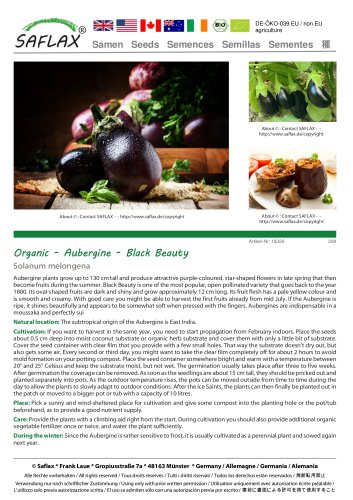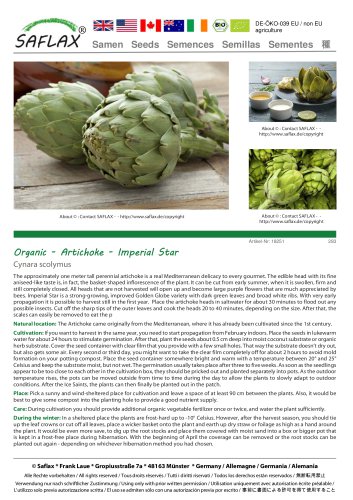
Catalog excerpts

Samen Seeds Semences Semillas Sementes 種 About © : Contact SAFLAX - http://www.saflax.de/copyright About © : Contact SAFLAX - - http://www.saflax.de/copyright About © : Contact SAFLAX - http://www.saflax.de/copyright Organic - Coriander Coriandrum sativum Coriander is sometimes called Chinese parsley because the leaves of Coriander and parsley look much alike. The taste, however, is completely different – Coriander is intensely spicy and aromatic. During late summer the flowers of the plant produce spherical schizocarpic fruits with a yellowish-brown colour. Unlike parsley, where mostly only the leaves are being used as seasoning, in Coriander also the stems and seeds are being utilized. The harvest season starts under normal summer conditions in June. Especially the young leaves have a finer taste. Cut the whole shoots near the ground or pick single leaves – best from top to bottom. You may chop up the Coriander and freeze it straight af Natural location: Coriander originally comes from the eastern Mediterranean. Cultivation: The best time for propagation is starting in February at a sunny place indoors as the seed is a light germinator. Scatter the seeds onto moist coconut substrate or organic herbal soil and slightly press them on. Cover the seed container with clear film to prevent the soil from drying out, but don’t forget to make some holes in the clear film and take it every second or third day completely off for about 2 hours. That way you avoid mold formation on the potting compost. Place the seed container somewhere bright and warm with a temperature between 20°C and 25° Celsius and keep the surface of the earth moist, but not wet (ideally using a water sprayer). Depending on the propagation temperature the first seedlings will come up after two to five weeks. Seedlings that are already raised indoors can be planted out with beginning of May. As soon as there is no more night frost expected, you can move the seedling with its complete root ball, to avoid stress for the plant. Place: The plant needs the sun, warmth and a wind-sheltered place to produce its full aroma. Care: Keep the soil always moist, but not wet. Water your plant as soon as the top layer of the earth has dried out. Fertilize the plant either very modest with compost or organic fertilizer for herbs, or don’t fertilize at all. During the winter: Sow again the next year. © Saflax * Frank Laue * Gropiusstraße 7a * 48163 Münster * Germany / Allemagne / Germania / Alemania Alle Rechte vorbehalten / All rights reserved / Tous droits réservés / Tutti i diritti riservati / Todos los derechos están reservados / 無断転用禁止 Verwendung nur nach schriftlicher Zustimmung / Using only with prior written permission / Utilisation uniquement avec autorisation écrite préalable / L'utilizzo solo previa autorizzazione scritta / El uso se admiten sólo con una autorización prev
Open the catalog to page 1All MSL GmbH & Co. KG catalogs and technical brochures
-
Organic - Wild Rocket
1 Pages
-
Levant Cotton
1 Pages
-
Indian Cedar
1 Pages
-
Chicory
1 Pages
-
Common Tobacco
1 Pages
-
Sunflower Titan
1 Pages
-
Organic - Squash - Delicata
1 Pages
-
Organic - Florence Fennel
1 Pages
-
Organic - Nettle
1 Pages
-
Organic - Chives
1 Pages
-
Organic - Basil Genovese
1 Pages





























